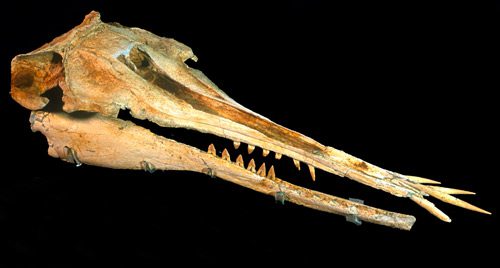You’ve seen a dolphin. You’ve seen an elephant. Put them together (sort of) and what do you get? Nihohae matakoi, whose tusk-like front teeth set it apart from modern dolphin species. A new analysis of a fossilized skull found in New Zealand in 1998 has revealed that it belonged to one of these charismatic creatures, and we can learn a lot about how they lived from their distinctive dentition.
For lead study author Dr Ambre Coste, the puzzle of the unidentified fossil remains was an irresistible challenge.
“The skull and jaw of this dolphin are exceptionally well preserved giving great insight into its possible feeding strategies,” Coste told IFLScience. “Though some of the rest of the skeleton was found it is not complete, consisting of only a few ribs and vertebrae. When I was suggested a variety of fossil dolphin skulls to study for my PhD at the University of Otago, this specimen really caught my eye and I found myself fascinated by the unanswered questions surrounding it.”
The remarkably preserved skull of N. matakoi, displaying its tusk-like teeth.
Image courtesy of Ambre Coste
The horizontal toothy protrusions at the front of N. matakoi’s jaw certainly mean it would have looked quite different from the modern dolphins we’re familiar with, but they also indicate that it could have used feeding methods that have never been described in marine mammals before.
“We suggest that it would have rapidly swung its head from side to side to injure or stun prey, making them easier to catch and eat as is seen in sawfish,” explained Coste. “It is believed to have hunted small soft bodied prey like squid as it shows no evidence of wear on any of its teeth. This lack of wear marks shows it didn’t use them to rummage through sand and the fact the front teeth are so flat indicates they wouldn’t have been useful for gripping prey like the Ganges river dolphin does.”
The front teeth are not true tusks, like those seen in elephants or narwhals, which never stop growing during the animal’s life. In fact, N. matakoi belongs to a group of early toothed whales called the waipatiids, all of which had teeth that stuck out from their mouths to varying extents. It’s thought all of these species went extinct during the late Oligocene/early Miocene periods, around 23 million years ago.
Coste explained that the name of the new species is derived from the Māori language: “Niho”, meaning teeth, and “Hae”, meaning slashing, refers to the possible feeding methods it deployed; while “Mata”, meaning face, and “Koi”, meaning sharp, describe its unusual facial anatomy.
Andrew Grebneff, one of the original collectors of the fossil back in December 1998, prepares the skull for analysis.
Image courtesy of Ambre Coste
The study authors write that further investigation using techniques like finite element modeling, as well as more in-depth analysis of contemporary species and other toothed whale specimens, will add to our understanding of the evolution of tusk-like teeth in cetaceans.
Dolphins have delighted and intrigued humans for centuries, as a quick Google of 1990s bedroom décor trends will confirm, but research like this shows us just how much there is left to discover about Flipper’s ancient ancestors.
“For me one of the amazing aspects of palaeontology is that it shows us that there is still so much to learn about the natural world and that nature has done so many cool and unusual things that I wouldn’t imagine on my own,” said Coste, “like having long pointy teeth that stick straight out of your mouth to go around slashing at squid.”
The study is published in Proceedings of the Royal Society B: Biological Sciences.
Source Link: 25-Million-Year-Old Extinct Dolphin Species Slashed Prey With Strange Tusk-Like Teeth
